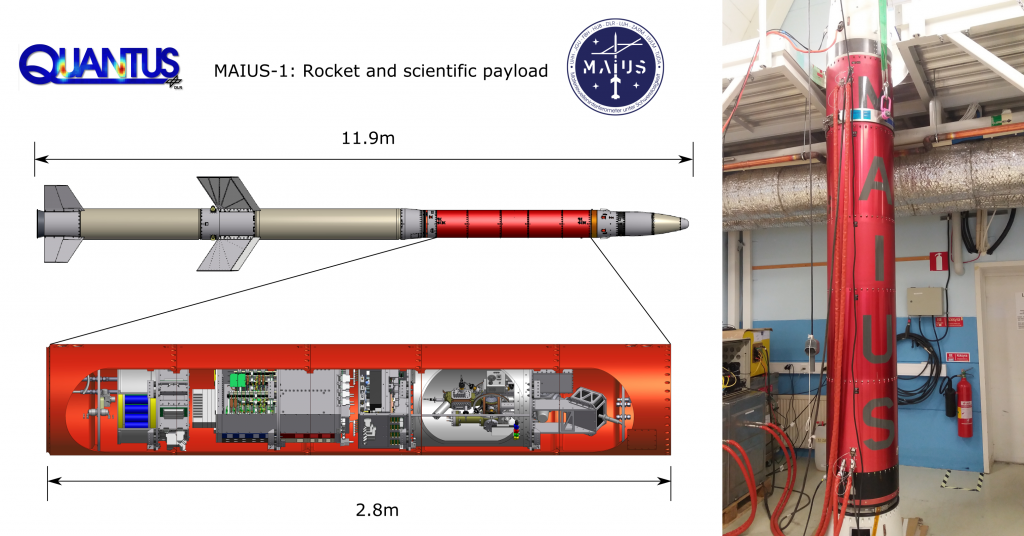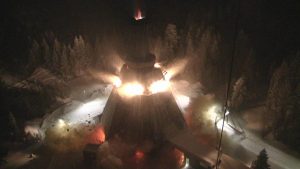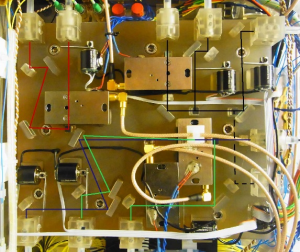
A sounding rocket features several minutes of continuous micro-gravity during its sub-orbital parabolic flight allowing to perform several experiments in direct succession.
Currently one flight was already successfully completed (MAIUS-1), and two further missions are planned, namely MAIUS 2/3.

In MAIUS 1, which was already launched on the 23rd of January, 2017, ultra-cold ensembles of Rubidium were studied. During the 6 minutes of micro-gravity, experiments studying the BEC-generation, internal state manipulation, magnetic lensing and atom interferometry were done.
During this flight the world’s first BECs in space could be generated.
Within the MAIUS-2 and 3 missions which are scheduled for launch in 2021 and 2022, those experiments are to be extended by a second atomic species, potassium. This then allows for the realization of a dual species interferometer, which is one of the major milestones towards a test of Einstein’s equivalence principle with a precision not feasible in ground-based laboratories.
The payloads for all three mission are set up in a collaboration of several German universities and research institutes, namely the Leibniz University Hannover, the Universität Hamburg, die Humboldt-University of Berlin, the University Bremen, the Ferdinand Braun Institute in Berlin, DLR research institutes in Bremen, Brunswick and Munich and us.
In this collaboration, we are responsible for the development of the optical systems interfacing the laser modules with the vacuum system, which are required for the cooling and manipulation of the atoms. This includes systems for the frequency stabilization of the lasers, and systems for the overlapping and splitting as well as switching of the different light frequencies and light paths.
To comply with the even more strict requirements than for the drop tower, especially concerning thermal stability, we developed a technological basis for those systems based on the glass ceramic Zerodur. This is a material developed by SCHOTT AG featuring a vanishing coefficient of thermal expansion, making it suitable for the application in environments with fluctuating temperatures.

For the successor missions MAIUS-2/3 the optical systems are much more complicated as next to the functionality of MAIUS-1, the capabilities for cooling and manipulating Potassium need to be added. This led to the implementation of a second wavelength (767nm) and the required overlapping of the two wavelengths by dichroic mirrors.
Due to the complexity involved, we decided to follow a modular approach and build seven individual Zerodur based optical modules. For each of the two species, one module provides an atomic frequency reference based on modulation transfer spectroscopy. Three single-input modules allow for fast switching of light using acousto-optical modulators. At each of the two input ports of the double-input modules, one laser dedicated to transitions of potassium and rubidium is connected. The light of both wavelengths is overlapped and jointly coupled into optical fibers to allow for addressing both species simultaneously.
All modules are currently characterized prior to integration into the complete laser system and delivery for first experiments with cold atoms.
Main Publications
[1] "Space-borne Bose-Einstein condensation for precision interferometry", D. Becker et al, Nature 562.7727 (2018)
[2] “A compact and robust diode laser system for atom interferometry on a sounding rocket”, V. Schkolnik, O. Hellmig, A. Wenzlawski et al. Appl. Phys. B 122: 217 (2016) [3] “Ultrastable, Zerodur-based optical benches for quantum gas experiments”, H. Duncker et al, Applied Optics 53, 4468 (2014) [4] "ZERODUR® based optical systems for quantum gas experiments in space", M. Mihm et al, Acta Astronautica 159, 166-169 (2019)Funding
The MAIUS project is supported by the German Space Agency DLR with funds provided by the Federal Ministry for Economic Affairs and Energy (BMWi) under grant number 50 WP 1433.

